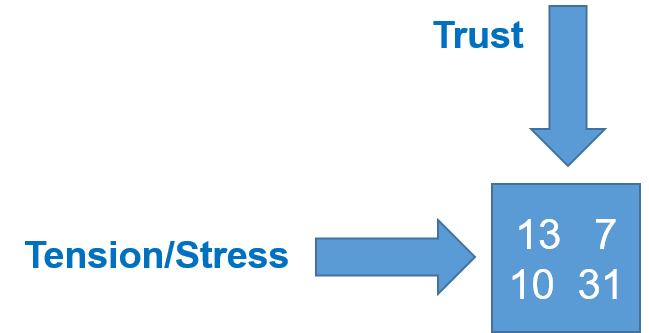By my estimate, over 80% of the Systematic Innovation work we did last year related to what I think of as ‘business innovation’. Which in reality usually meant ‘people innovation’. Developing breakthrough technical solutions is now by far and away the easiest part of almost any innovation project. The real difficulties only begin to appear when people are asked to change from what they’re currently doing to what’s needed. People love change. They hate being changed.
Which sounds like a contradiction. And, surprise, surprise, the vast majority of ‘people innovation’ challenges also involve contradictions. Hence the reason for the big leap in ‘intangible’ related parameters in the third edition of the Business Contradiction Matrix.
The biggest challenge populating the tool has been finding a critical mass of real-world case studies to reverse engineer. The business literature has been a primary source of information, but when it comes to conflict situations at the personal level, the well is mostly dry. In true, ‘someone, somewhere already solved your problem’ fashion, we’ve long speculated on the rich outpourings of the world’s agony aunts and uncles. In a world where almost every newspaper or magazine includes a daily personal advice story, theoretically it shouldn’t take long to be able to accumulate tens of thousands of stories. In practice of course, the moment we find ourselves talking about humans, we’re also talking about complexity. Which in turn means that any agony aunt/uncle takes a tightrope walk as far as being able to offer meaningful advice to a correspondent that has probably only supplied a couple of paragraphs of background information. Couple that with the even bigger problem that once the aunt or uncle has dispensed their sage advice to said correspondent, the loop rarely if ever gets closed. Meaning that the efficacy of their advice remains largely unknown and unknowable.
This latter problem has ultimately been the one that caused us to shy away from the whole agony domain. Well, that plus the fact that most of us are engineers and therefore assumed to be somewhere along the autistic spectrum. Usually, in my own case, at the non-empathic end.
Anyway, a year and a half of lockdown ends up having an impact, one of which being what feels like an explosion in the number of people seeking advice, another being that I’ve now read enough of said ‘advice’ to recognise the whole agony aunt & uncle game is largely, like large parts of the psychiatry/psychotherapy world, a quasi-scientific sham. We might not be able to close the loop on the efficacy of agony-relieving advice, but we can at least take a heap of randomness out of the advice being dispensed to the lost, lonely and confused.
So, by way of a brief taster of what’s to come, here’s a small example from one of the less sensationalist of the agony aunt’s working in the UK today, Annalisa Barbieri from the Guardian, and the latest of her weekly ‘Family Ask’ columns (Saturday, June 19 – https://www.theguardian.com/lifeandstyle/2021/jun/18/disinvite-unsupportive-family-from-my-wedding).
The gist of this week’s contradiction is as follows:
“My partner and I are getting married this summer. It is a small wedding, and I have invited my mum and siblings. However, most of my family members are not supportive of my relationship… My partner and I are worried about how they might behave at the wedding, but I am concerned that disinviting them would be seen as aggressive… I feel torn: I don’t want to deepen the rift that exists, but at the same time I don’t want their behaviour to ruin our wedding.”
All in all, a fairly clear contradiction: should the worried bride-to-be un-invite her relations from the wedding, or allow them to potentially show-up and disrupt proceedings. Here’s what the problem looks like when mapped onto a Bubble Map:

As far as the Matrix is concerned at this point, the big idea is that the bride to be is not the only person in the world seeking to avoid aggression and crossing their fingers and trusting that the invited relatives won’t disrupt the day. The conflict, in Matrix terms, is a classic tension/stress versus trust conflict pair. For which the Matrix tells us the most frequently used contradiction-solving strategies are:

Which, when I look at Ms Barbieri’s advice (or rather psychotherapist, Henry Adeane, who she asked to tackle the problem) seems to fit rather well.
The main crux of that advice makes for an elegant illustration of Inventive Principle 10, Preliminary Action – or ‘do something in advance’:
“… inviting your mum and the difficult sibling to a meal, “somewhere neutral. Be kind and gentle but firm, and say something such as, ‘I don’t think you want to be at the wedding, and I don’t want you to be there if you’re not comfortable with my relationship and marriage.’”
Then, the follow-up, this time an on-the-money illustration of Principle 31, ‘Pause’:
“…looking at the way you respond to what they say: if you feel peaceful and as if you’ve cleared the air, then possibly this is a goer. But if you feel tense and wrongfooted, then it’s best if you disinvite them. And, remember, it’s fine to take a day or two after the meeting to think about the way you feel and decide what to do.”
One bride-shaped swallow doesn’t make a summer of course, but we’ve now analysed enough of these types of case (one of the non-engineer member of the SI Network has been using TRIZ in marriage-guidance counselling for several years now) to see a relevance that begins to turn the quasi-science story around the other way. If the Matrix is pointing in the same directions as the psychotherapists, and is based on cases where we have been able to close the loop (so we know the directions have delivered success in business settings), does that mean it becomes the ‘evidence-based’ data that the psychotherapists always want but have never thus far had? It’s probably a long road ahead, but there’s no better time to embark on long roads than times of crisis. Like the pandemic-driven mental-health tsunami heading our way.
